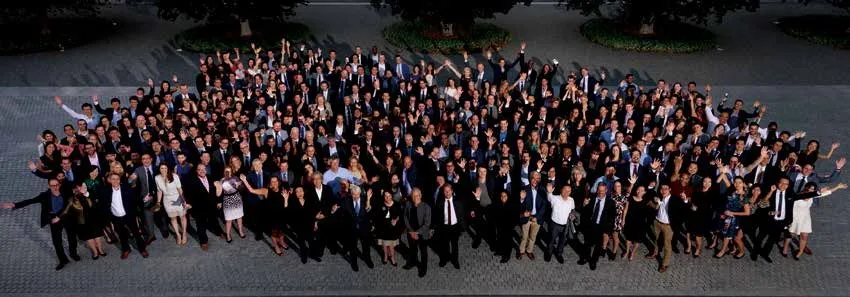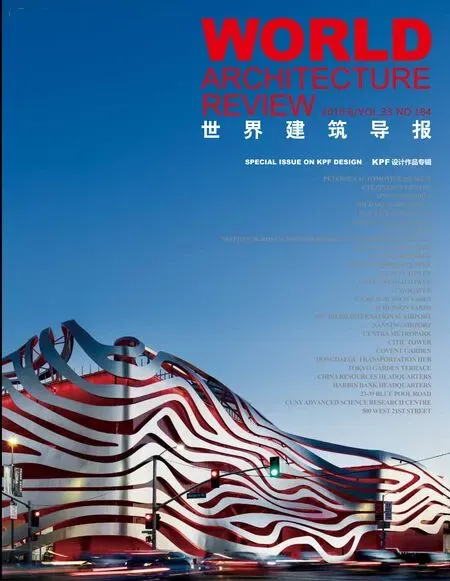美国KPF合伙事务所简介

photo: Kohn Pedersen Fox
KPF(Kohn Pedersen Fox Associates)成立于1976年,目标是将建筑艺术和商业结合起来。在成立的第一个十年里,其在纽约的实践已经成为美国办公楼设计的杰出典范,以及少数几家旨在恢复城市在二战后的郊区化进程中逐渐丧失的魅力的美国设计公司的领军者。随着实践的深入,其工程在建筑类型和地域方面得到了拓展。委托的业务发展到包括城市、文化、机构、酒店、住宅、交通和各种规模的基础设施项目中。这种多产的、跨行业的专业知识推动了KPF目前在多功能建筑领域的领导地位,尤其是它在建筑和社区尺度上的设计倾向。
如今,30名负责人带领着650名来自9个紧密联系的国际办事处员工,在超过45个国家从事设计工作。尽管KPF规模庞大,但它仍保持着一种小规模实践的精神,在这种实践中,设计和制造的过程是通过开放的思想交流和合作发展起来的。工作人员会说40多种语言,在全球范围内合作,从概念设计到施工管理,共同承担责任。即使其覆盖面很广,公司独特的方法促成了一个共同的目标——为每个项目找到最明智的解决方案——通过其以比较为主的设计流程来实现。
公司的作品集说明了这种建筑追求。才华横溢的个人在工程中利用丰富的知识、才华和工艺,为各种类型、规模以及所有地理区域的建筑做出了贡献,包括许多世界上最高的塔、最多样化的项目和创造性的建筑形式,从超级摩天大楼到低层社区。本期《世界建筑导报》关注的是KPF的设计流程,突出了KPF在工艺方面的成就。28个项目代表不同的类型,强调当地文化和景观的融合。案例研究记录了选择、制造和应用材料的详尽而复杂的实践。它们或强调制造者的角色或肯定计算机建筑学的未来。设计的目的是充分展示工作室在高质量和环境敏感的建筑设计方面的实力。KPF颂扬集合作者、调查者、问题解决者和制造者的角色为一身的建筑师。
KPF was founded in 1976 with the objective of marrying art and commerce in architecture. Within a decade, the New York City practice had emerged as the pre-eminent author of office buildings in the United States, a leader among a handful of American firms that were revitalizing cities with the charisma that suburbs had drained after World War II. As the practice progressed, its work expanded in typology and geography. Commissions grew to include civic, cultural, institutional,hotel, residential, transportation, and infrastructure projects of varied sizes. This prolific, cross-sector expertise propelled KPF’s current leadership in mixed-use architecture, and in particular, its penchant for designing at the scale of both building and neighborhood.
Today, 30 principals lead 650 staff members in nine, interconnected, international offices, designing in more than 45 countries. Despite its formidable size, KPF maintains the spirit of a smaller practice,in which the process of design and fabrication is developed through the open exchange of ideas and collaboration. Speaking more than 40 languages, the staff collaborates globally, sharing responsibilities from conceptual design through construction administration. Even with its wide reach, the firm’s singular approach promotes a collective goal—finding the smartest solution for each project—achieved through its comparative design process.
The firm’s portfolio illustrates this architectural pursuit. Talented individuals bring a wealth of knowledge, talent, and artisanship to their work, having contributed to buildings of all types and scales and in all geographic regions, including many of the world’s tallest towers, most varied programs, and inventive forms. With a focus on process, this issue of World Architecture Review highlights the firm’s achievement in craft, from the supertall skyscraper to the low-rise neighborhood. Nearly thirty projects represent diverse typologies, stressing the integration of local cultures and landscapes. Case studies chronicle the intimate yet complex practice of choosing, manufacturing, and applying materials. They emphasize the role of the fabricator or the future of computational architecture. The intended result is a thoughtful demonstration of the studio’s prowess in the design of high quality and contextually sensitive buildings. It celebrates the architect as collaborator, investigator, problem-solver, and maker.

